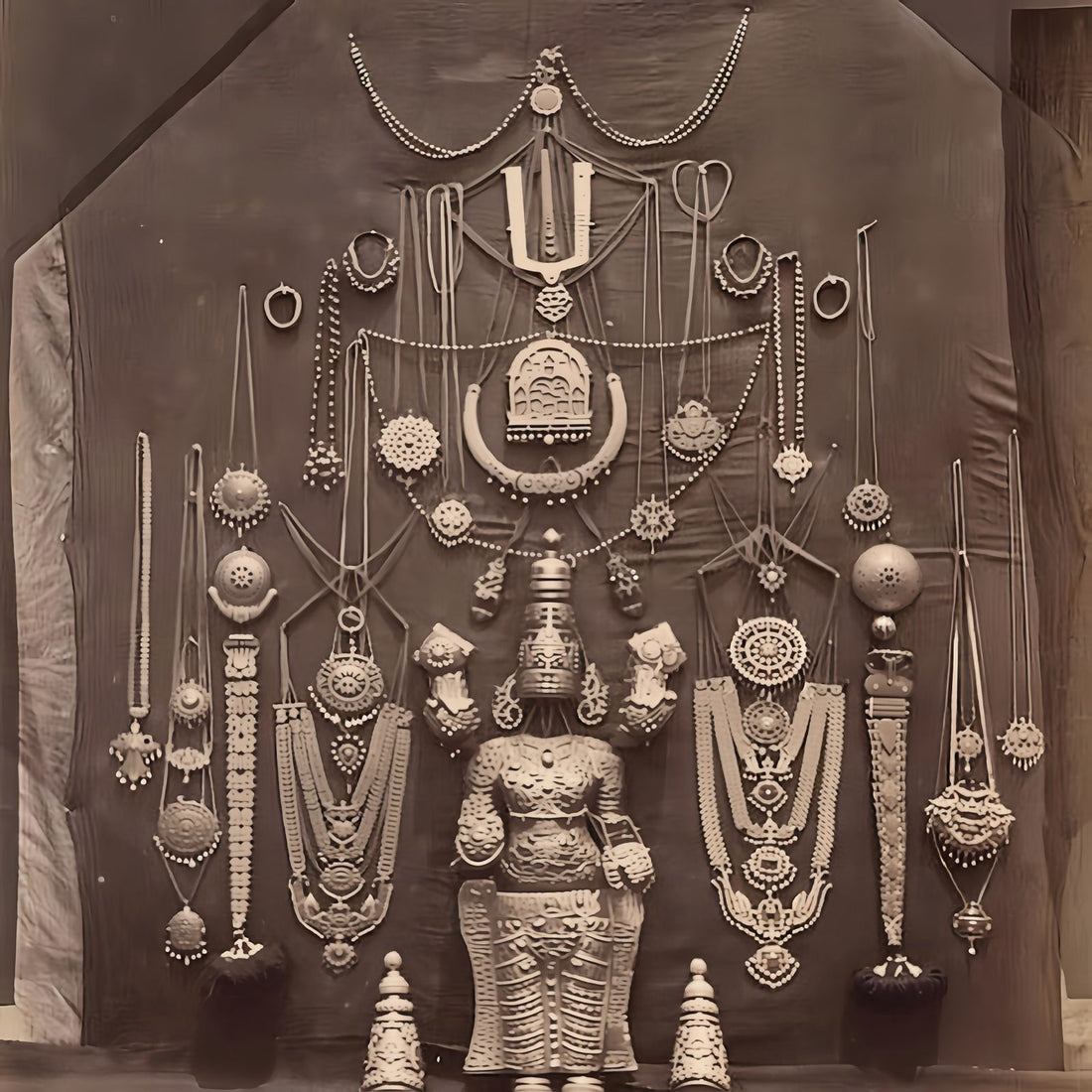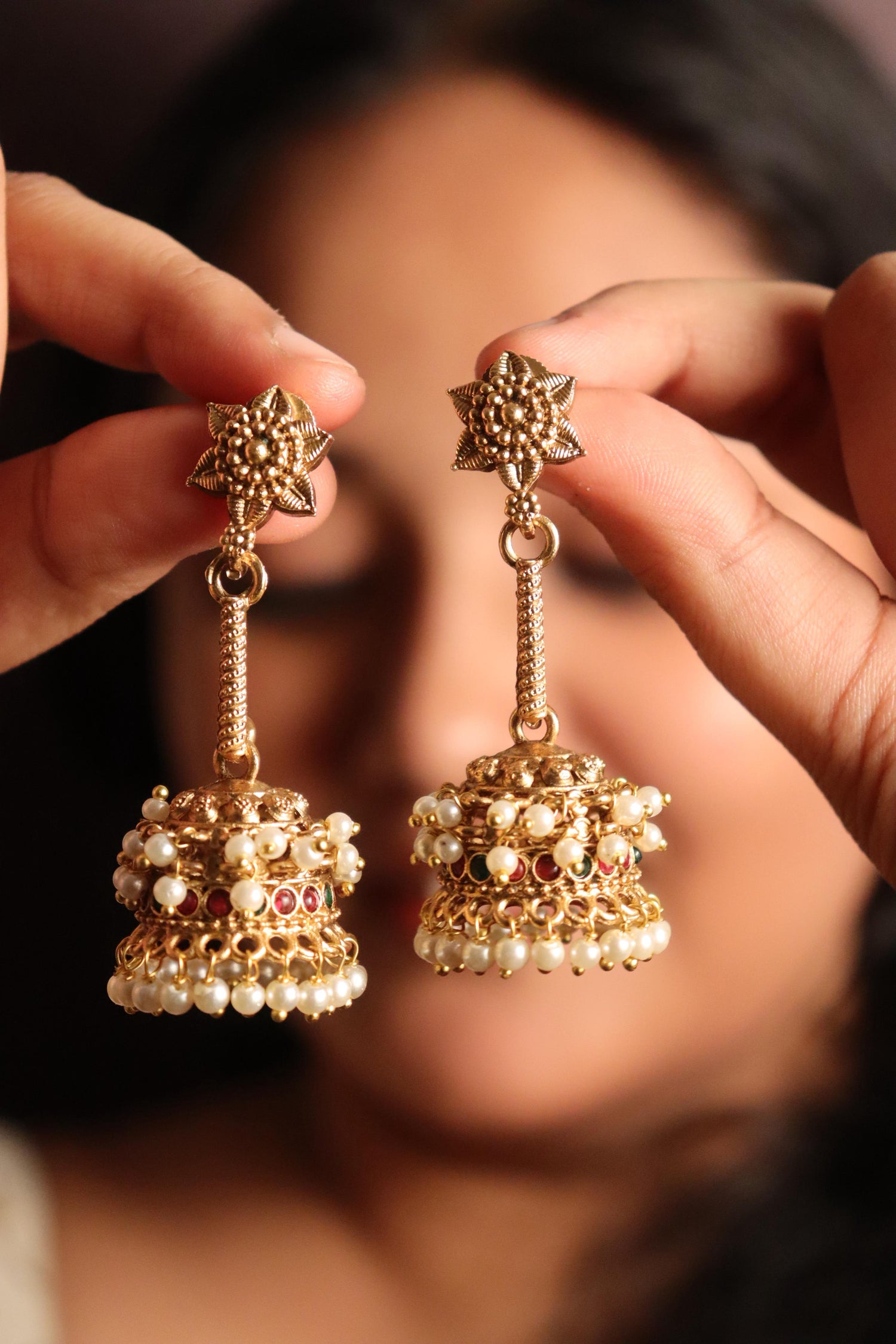
Temple Jewelry: A Sacred Evolution Through Civilizations, Empires & Erasure
Share
We often wear jewelry to express — but in ancient India, jewelry was worn to invoke.
The sacred genre known as “temple jewelry” is more than an aesthetic category; it is the materialization of Indian spirituality, shaped across dynasties, rituals, and philosophies.
And while it’s often attributed to the temples of Tamil Nadu or classical dance forms like Bharatanatyam, its roots go far deeper — into the Vedic imagination, and its branches far wider — into temples from Odisha to Gujarat, Maharashtra to Bengal.
This is the untold story of temple jewelry: its birth in ritual, rise through empire, decline under colonial rupture, and revival in modern identity.
🔱 I. Vedic Period: Jewelry as Cosmology and Offering
(c. 1500 BCE – 500 BCE)
The earliest Indian conception of jewelry wasn’t ornamental — it was ritualistic and cosmic. In Vedic literature, the act of adorning oneself — or the deity — was not vanity but sacred alignment.
• Rigveda, Yajurveda, and Atharvaveda all reference ornaments made of gold (hiranya), silver, beads, ivory, and shells. These were tied to celestial symbols: the sun (Surya), the moon (Chandra), the cosmic axis (Meru).
• Adorning the gods was an extension of puja — the deity wasn’t complete until "shringar" was performed.
• Early temples, although not yet grand in architecture, had portable icons that were clothed and ornamented using metal, rudraksha, and natural stones.
Gold was believed to carry surya tejas (solar energy) and promote health and longevity. Metals were not just carriers of beauty but conduits of prana (life force).
Thus, jewelry emerged as a spiritual science — balancing the doshas, protecting from the drishti, and manifesting the divine through the body.
🏛 II. Chola Dynasty & South Indian Temples: The Zenith of Sacred Craftsmanship
(c. 850 – 1279 CE)
Temple jewelry as we recognize it today crystallized under the Chola Empire in Tamilakam (modern Tamil Nadu). The Cholas were not just builders of temples, but curators of sacred economies — commissioning art, dance, bronze sculpture, and jewelry as an integrated devotional system.
• Deity adornment (abharana) reached peak ritual significance — bronze murtis of Shiva, Parvati, Lakshmi, and Vishnu were lavishly decorated in gold ornaments, rubies, emeralds, and intricate craftsmanship.
• The “alankara” of the murti was a public spectacle — specific ornaments for each deity, aligned to festivals, astrological cycles, and temple rituals.
• Devadasis, women dedicated to temple service through dance and music, were adorned in identical motifs as the deities they danced before. For them, jewelry was not an accessory but an extension of devotion.
• These pieces — now termed "temple jewelry" — were typically handcrafted in gold, with motifs like makara (mythical crocodile), yali (lion-like beast), lotuses, coins, peacocks, conch shells, and goddess Lakshmi.
This was not fashion. It was civilizational aesthetics — where the sacred, the symbolic, and the sovereign converged in ornamentation.
🕌 III. Beyond the South: Temple Jewelry in Other Sacred Landscapes
While South India formalized temple jewelry as a system, other regions evolved their own sacred ornamentations, often rooted in local deities, temple iconography, and folk mythology.
✦ Odisha
• Jagannath Temple traditions led to silver filigree work (tarakasi) with Krishna, chakra, and tree-of-life motifs.
• Tribal communities like the Dongria Kondh wore raw silver with mountain-deity inspired carvings.
✦ Rajasthan & Gujarat
• The Thewa art of Rajasthan involved embossing gold images of Krishna, Ganesha, and Durga onto glass — mini temples in themselves.
• Gujarat’s Pachchikam jewelry used uncut glass and silver to mimic ancient deity jewelry from the Somnath and Dwarka temples.
✦ Maharashtra
• The Kolhapuri Saaj — a necklace with 21 pendants — included tulsi leaves, Shiva’s damaru, Ganesha, and Lakshmi, each one a prayer in gold.
• Ornamentation here had agro-spiritual roots — worn as symbols of fertility, devotion, and village deities.
Temple jewelry thus had regional dialects — all speaking the same sacred language.
⚔️ IV. British Colonization: The Systematic Disruption of Sacred Adornment
(c. 1757 – 1947)
The arrival of the British Empire brought with it a desacralization of Indian aesthetics.
• The Devadasi system was abolished, and with it, the institutional memory of sacred adornment. What was once revered became labeled as “immoral.”
• British laws promoted westernized jewelry aesthetics — focused on diamonds, symmetry, and “refinement.” Sacred Indian motifs were seen as “barbaric,” and temples were looted for gold.
• Jewelry was monetized and industrialized. What was once handcrafted by temple-affiliated goldsmiths became commodified through colonial trade.
This was not just a cultural loss — it was a philosophical rupture, severing Indians from the energy logic of their jewelry traditions.
🌸 V. Post-Independence Revival: Memory, Modernity, and the Sacred Return
The 20th-century revival of temple jewelry began quietly — not in jewelry stores, but in dance schools and performance stages.
• Visionaries like Rukmini Devi Arundale, Balasaraswati, and Kelucharan Mohapatra revived classical dance forms — bringing back the authentic temple ornamentation as part of performance.
• Parallelly, artisan communities in Kanchipuram, Chettinad, and Odisha restarted lost forms of temple jewelry for wedding use, classical dancers, and temples.
• Today, temple jewelry has re-entered the public sphere as not just performance wear or bridal wear — but as a cultural and spiritual statement.
And yet, much of the public still sees it through the narrow lens of South Indian weddings or Bharatanatyam dancers.
🪔 At Viyara, We Believe Temple Jewelry Is a Nation-Wide Inheritance
We do not see temple jewelry as a niche or a region.
We see it as India’s quiet genius — where aesthetics meet healing, mythology meets metal, and ornament becomes offering.
Whether it is a choker carved with Lakshmi, a pendant inspired by Garuda, or silver anklets designed after temple bells — it’s all part of a sacred technology of self-expression.
Jewelry that began in temples…
Now returns to your skin, your stories, your sense of self.
Not as fashion — but as memory.
Not as trend — but as legacy.
Wear what you resonate with.
Wear Viyara.

